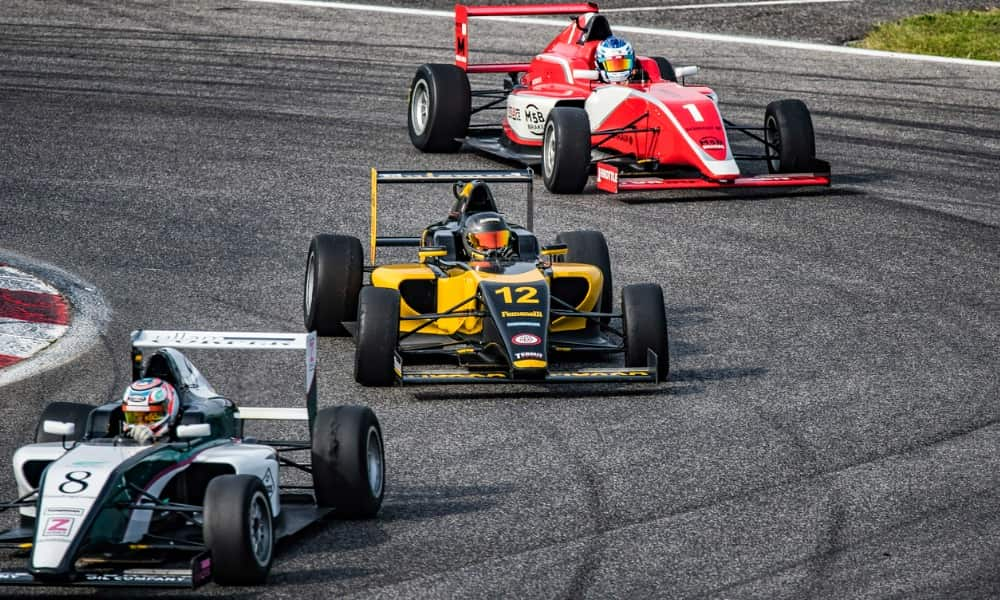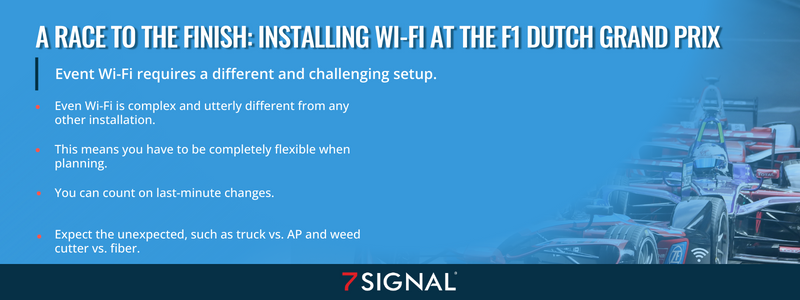
Blog
Event Wi-Fi requires a different and challenging setup.

Event Wi-Fi is different from any other Wi-Fi setup, thus requiring extreme flexibility in highly challenging environments, above and beyond the typical planning process.
A prime example is the 2022 F1 Dutch Grand Prix, attended by more than 300,000 people. Since guest Wi-Fi wasn’t offered at the event, the question was how would the press, vendors, and staff stay connected.
The answer? A temporary Wi-Fi infrastructure. In High Speeds and Wi-Fi at the F1 Dutch Grand Prix, Raymond Hendrix, CWNE #274, discussed how he worked with the Wi-Fi team at the G1 Dutch GP to set up the temporary network in just 90 days.
Assessing the environment
Assessing the environment is crucial when planning for a large-scale event. Understanding the types of clients that will be accessing the Wi-Fi network is the first step in designing a network. In this case, the iPads used for payment were identified as the least capable, most important device (LCMI), while the local organizing committee and construction crews brought their own devices, resulting in a bring-your-own-device (BYOD) environment.
In setting up Wi-Fi 60 days before the event, the prior year’s map was used for a preliminary plan to determine where Wi-Fi was needed.
.png?width=867&height=629&name=image3%20(8).png)
However, once the actual map was received, it was revealed that temporary seating had been built with scaffolding to seat over 70,000 people in new areas. Wi-Fi was required in the seating areas. Wi-Fi also was needed in VIP and press tents and the F1 Paddock Club, along with the track entrances for barcode scanning and the payment network.
The installation
A fiber-based mesh network for audio, video, and data, was installed as a basis for Wi-Fi. The Wi-Fi network was built on that by deploying about 35 miles of temporary fiber for Wi-Fi, mixing Wi-Fi 5 and Wi-Fi 6, plus controllers and firewalls with uplinks for data separation among the different client groups.
This required an inverted design. A small pop-up tent was created under a massive amount of scaffolding. Attenuation is not due to building materials but humans, however. Thus, everything was designed bearing the user in mind – to accommodate 100,000 people daily, 2.5 dBs per meter.
Since a large number of devices were being used, 2.4GHz wasn’t deployed. The network had to be designed for the LCMI with reliability in mind so payments could go through.
Twenty MHz was used for the payment areas and 80 MHz for the press area in the center because they needed a Wi-Fi speed boost. Since there weren’t any payment terminals nearby, it worked out well.
With 100,000 devices probing, as well as wild card probes, the minimum data rate needed to be higher than 18 megabits per second. Multi-user MIMO was disabled because it can cause environmental instability.
The AP names were enabled as broadcasters in the beacon to make it easier to recognize the AP troubleshooting connection.
Everything was double-checked days before the event, to handle necessary tweaking. Some areas had to be changed to bar or shop areas. Last-minute changes can always be expected when setting up Wi-Fi for an event.
The request was to “do it the same as last year”
The number of attendees was underestimated. Fewer spectators and press members attended in 2021 because of COVID-19. The press total increased from about 150 to more than 400 in 2022, which made the press tent a high-density area.
What is the fix? You can try adding only omni access points and place them in certain areas and ensure they choose a small cell. This solution wouldn’t handle the multitudes of users requiring Wi-Fi, however.
As a result, power sockets were rolled in. Flexibility and adaptability are necessary in cases like this to ensure the Wi-Fi stays up and running. For example, the crew used zip ties and gaffer tape when a truck ran over an access point.
You can ensure a stable network, even working into the wee morning hours, but things still happen. For instance, you return later in the morning and notice some APs and switches are down. Why? Somebody cleaned the track with a weed cutter. It was weed cutter against fiber, and now 300 payment terminals were down. Fortunately, this occurred during a pre-event, and at T minus zero, all the issues were worked out.
Contact 7SIGNAL to learn more
The 7SIGNAL engineers help design better Wi-Fi networks using real-time, accurate information. Remember, you can’t see or hear Wi-Fi, but 7SIGNAL can.
Contact us to learn more about our wireless experience monitoring platform.
7SIGNAL® is the leader in wireless experience monitoring, providing insight into wireless networks and control over Wi-Fi performance so businesses and organizations can thrive. Our cloud-based wireless network monitoring platform continually tests and measures Wi-Fi performance at the edges of the network, enabling fast solutions to digital experience issues and stronger connections for mission-critical users, devices, and applications. Learn more at www.7signal.com.